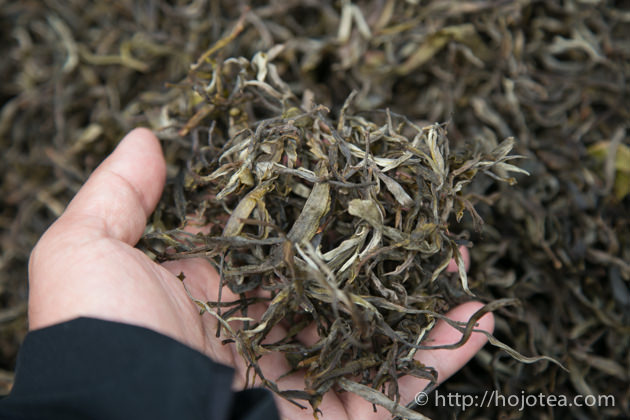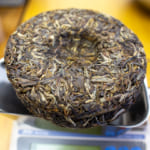- HOME >
- Types of Tea
Development of lightly rolled Japanese green tea
- [2016.02.11] Posted By Akira Hojo
Japanese green tea is less lasting in brewing
Many people may find that the taste and flavor of Japanese green tea do not last over many infusions. The first infusion is strong and flavorful, but on third or even the second infusion, most of Japanese green tea tastes light and plain. Regardless of the brewing style, it is mainly because of the tea leaf is rolled very tightly. Because of this, when tea is brewed the taste and flavor comes out very quickly. Many of us are accepting it since we think it is the nature of Japanese green tea. However, I started wondering why it is rolled so tightly. If Japanese tea is rolled lightly, it should be able to last many more infusions.
The appearance of tealeaf influences the process
In Japan, the shape of tea leaf is considered as one of the very important quality criteria. The tea leaf with needle shape is being highly appreciated. Some people appreciate hand-rolled Japanese green tea and willing to pay a high amount for it. Usually the slimmer the tea leaf, the higher the pressure is given. As a result, more cells have been macerated, and more substances are extracted during tea brewing. However, the rolling is not really affecting the base characteristic of green tea. The characteristic of green tea is set based on the steaming time and the extent of heat treatment in the subsequent process. Thus, the tighter rolling is purely meant for the elution of tea constituents.
White tea is produced without rolling
In fact, some teas are produced without rolling, for example, the white tea. The process of white tea is as follow:
Withering >> Heating to stop fermentation >> Drying >> Moderate baking. Despite the white tea is not rolled, we still enjoy the flavor and taste of white tea just like other teas. Thanks to no rolling process, the freshness of white tea lasts over many brewing. Generally, as compared to other tea categories, the rolling for raw pu-erh tea is very gentle. We sometimes come across the pu-erh tea that is rolled very tightly. No doubt that the flavor of these teas lasts shorter than those that are rolled softly.
The rolling is important for black tea
In making black tea, the rolling process is very important. When tea leaves are macerated in rolling action, the enzyme and substrate in tealeaf mixes together and initiate enzymatic fermentation. In making black tea, rolling is one of the critical processes which affect the consistency of fermentation. But the process of making green tea involves no fermentation. Then why is it so important to roll green tea so tightly?
The requirement of Umami may caused the Japanese green tea is tightly rolled
Why Japanese green tea is rolled tightly? One of the reasons could be due to the umami, which has been often regarded as a quality index of Japanese green tea. Umami is the amino acid compound called theanine. https://hojotea.com/en/posts-47/

Umami in tea was discovered by Dr. Sakado in 1950s. Since then people started to associate umami with the quality of green tea. This idea has been greatly supported since it matched the modern agricultural practice. This idea back-up the modern agricultural practice since the more umami is composed if more fertilizer is used. The idea of umami as a quality index made everyone very happy. It created the demand of fertilizer, and based on the umami index, the quality of tea grown with fertilizer was justified. At the same time, rolling became very important. With tighter rolling, the more umami substance will be eluted during tea brewing.
However, the more umami means more fertilizer. In tea, the extent of umami and the level of aftertaste is at inverse proportion, i.e., more umami tea normally has less aftertaste. In order to accumulate more mineral content, tea tree has to grow slowly under the severe environment. In Chinese, Taiwanese and Indian tea, the aftertaste is rather a more important tea quality index.
Developing very lightly rolled Japanese green tea
Generally, I am always looking for the tea grown in natural farming style. Natural farming means no nitrogen fertilizer is used, not even the organic nitrogen fertilizer. As compared to the tea grown in modern agriculture, the natural farming tea contains less theanine but a lot of poly phenol and minerals. Since the natural farming tea contains less amino acid, there is no reason we have to roll it tight. The main characteristic of natural farming tea is strong aftertaste and floral scent. To enhance this characteristics and makes tea lasting over many brewing, light rolling is definitely a good idea. With light rolling, the energy applied during process is lower. In addition, the surface of tea leaf is less than those that are rolled tighter and macerated more. Thanks to these facts, tea undergoes less oxidation during the process. As a result, not only we can brew tea many times, and also the tea becomes floral and very refreshing. Based on these ideas, I am planning to develop new style of Japanese green tea this year. I plan to use very light rolling and enhance the floral flavor. Since last year tea season, I have already started this project. We have conducted several trial runs in Tsukigase. If everything goes well, I should be able to introduce it this year.
Related Articles
How to get the latest update on HOJO?
1. Follow Twitter, 2. Click "Like" on Facebook, and 3. Subscribe in newsletter. You can have the latest tea news from HOJO.
 Subscribe the Newsletter to enjoy the privileges
Subscribe the Newsletter to enjoy the privileges- You may receive a free sample upon purchase, or you may have the priority to purchase special products. So please remember to subscribe our newsletter as well as the social network.
- New Arrival of Akitsu Mumyoi and Nosaka Rough Clay Teapot
- A wide selection of teaware by Watanabe Tozo, a Sado-based artist of Mumyoi-yaki, has just arrived. This time, …
- Mang Fei Ripe Pu-erh Tea 2023 – Small-Batch Production from a Renowned Region
- Mang Fei Ripe Pu-erh Tea 2023 is now available. This is one of the highest-quality ripe pu-erh teas among our …
NEW ARTICLES
 Development of Firewood Roasted Hojicha Using Naturally Grown Tea from Yunnan
Development of Firewood Roasted Hojicha Using Naturally Grown Tea from Yunnan- We are currently staying in Yunnan Province for tea production. As the season nears its end, tea trees with pa …
 Exploring the Food Culture of Yunnan: Where Minority and Sichuan Cuisines Meet
Exploring the Food Culture of Yunnan: Where Minority and Sichuan Cuisines Meet- We are currently staying long-term in Yunnan Province for spring tea production. On rainy days or when there i …
 New Arrival of Akitsu Mumyoi and Nosaka Rough Clay Teapot
New Arrival of Akitsu Mumyoi and Nosaka Rough Clay Teapot- A wide selection of teaware by Watanabe Tozo, a Sado-based artist of Mumyoi-yaki, has just arrived. This time, …
 Managing Yunnan White Tea — Insights from the Field
Managing Yunnan White Tea — Insights from the Field- Since March 25, we have been in Yunnan Province, fully engaged in the production of white tea. In this column, …
 Mang Fei Ripe Pu-erh Tea 2023 – Small-Batch Production from a Renowned Region
Mang Fei Ripe Pu-erh Tea 2023 – Small-Batch Production from a Renowned Region- Mang Fei Ripe Pu-erh Tea 2023 is now available. This is one of the highest-quality ripe pu-erh teas among our …
 Yunnan Tea Trends 2025: Insights from the Fields
Yunnan Tea Trends 2025: Insights from the Fields- Since March 25, we have been in Yunnan Province. We will stay here until May to conduct tea production, packin …
 Why Do Some Teas Taste Astringent? Exploring the Causes and Mechanisms of Astringency
Why Do Some Teas Taste Astringent? Exploring the Causes and Mechanisms of Astringency- Tea can range from having no noticeable astringency to possessing a very strong one. What causes this astringe …
 The Impact of Heat Sources on Tea Flavor
The Impact of Heat Sources on Tea Flavor- It is widely recognized that the material of a kettle plays an important role in shaping the taste of water fo …
 New Release of Tang Li Shan Ripe Pu-erh Tea 2023
New Release of Tang Li Shan Ripe Pu-erh Tea 2023- We have released the 2023 edition of Tang Li Shan Ripe Pu-erh Tea. Tang Li Shan refers to a mountain located o …
 The New Release of Dong Shan Raw Pu-erh Tea 2023 and Jasmine Silver Needle
The New Release of Dong Shan Raw Pu-erh Tea 2023 and Jasmine Silver Needle- We have released Dong Shan Raw Pu-erh Tea 2023 and Jasmine Silver Needle. Dong Shan Raw Pu-erh Tea 2023 We hav …
Category
- New Arrival at HOJO Online Shop
- Featured Articles
- Newsletter
- Types of Tea
- Origin of Tea
- Teapot and Tea Equipment
- Tea Column
- How to enjoy tea
- Tea Processing
- How to choose quality tea
- Tea constituents and functional effect
- Safety of Tea
- Foods
- Tea Business Operation
- Hobby and Outdoor Activity
- Ranking of Tea
- Video
- FAQ
- Media Release
Profile

- AKIRA HOJO
- I invite you to experience my tea selections.I was born in Nagano, Japan. In university, I studied agricultural chemistry, and I have the master degree in food science. I worked in Japanese food industry for 10 years. I involved in R&D, QC and QA. As a factory manager, I implemented ISO9000 series and managed the factory.
- The Art of Tea Magazine
- We posted the article on “The Art of Tea Magazine No.9, the magazine is published in Taiwan. We featured …
- New Straits Times
- The Malaysian National Newspaper, New Straits Times featured HOJO Tea on 17-Oct-2007.
Shop Info

Address:Lot No. T-215, 3rd Floor, The Gardens Mall, Mid Valley City, Lingkaran Syed Putra, 59200 Kuala Lumpur
Tel: +603-2287-4537
Business Hour: 10am to 10pm

















